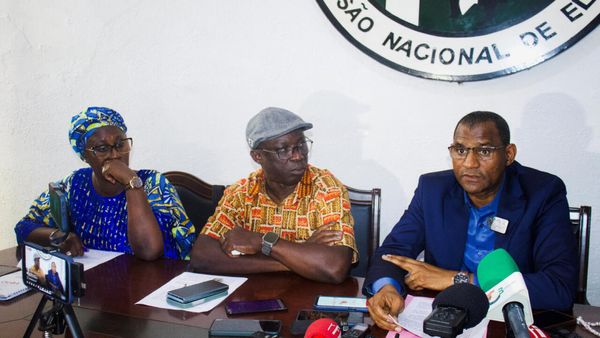
The brawny bruins on the Alaska Peninsula are ready to brawl it out to see which will win this year’s fattest bear title in the wildly popular annual online voting contest known as Fat Bear Week.
The main event featuring adult bears starts next week, but first up Thursday, is what the National Park Service calls a “chubby cubby appetiser.” Fat Bear Jr. voters can cast ballots through Friday for their favourite adolescent ursine, with the winner advancing to the big show.
The contest, which began in 2014, is meant to showcase the resiliency of the brown bears, which pack on the pounds each fall to survive the harsh winter by gorging on salmon at Brooks River in remote Katmai National Park and Preserve.
People can watch the bears on livestream cameras, and spectators from around the world are invited to cast their vote to determine which bear has accumulated the most impressive fat reserves this year.

“It really is an opportunity for people to think about how bears survive, what they need to do to survive, what the ecosystem provides them and look at their individual success stories, as well,” said explore.org naturalist Mike Fitz, who started the contest when he was a ranger at Katmai.
This year's sockeye run has been abundant, so voters can expect some especially corpulent contestants.
Here’s a closer look at the popular online event.
How to vote in Fat Bear Week
The 12 bears, which will be announced on Monday, will be featured in the single-elimination, bracket-style tournament. All voting is done online at www.fatbearweek.org, with the winner declared on 30 September.
The first round features eight bears squaring off in four separate contests to advance to the second round. Four bears receive first-round byes.
There are about 2,200 brown bears within Katmai, a 16,997-square-kilometre park on the Alaska Peninsula, which extends from the state’s southwest corner toward the Aleutian Islands. It is the fourth biggest National Park in the US with diverse ecosystems and wildlife - including its famous brown bears.
To be featured in the contest, the bears must frequent the area of the main Brooks Camp.
Getting a bear on a scale is impossible
Actually weighing the bears would be a dangerous and monumental task, so it's up to voters to judge size by looks alone.
During hibernation, the bears can lose up to a third of their body weight as they can't eat or drink until they emerge in the spring. In preparation, they feed the richest and most available food during the summer and autumn to bulk up. In Katamai National Park, that means salmon.
From late June until mid-October, dozens of bears gather at the Brooks Camp to feed on these fish. Some bears can eat more than 40 salmon in a day.

Their winter survival depends on developing ample fat reserves before they enter their den for the winter. That means a fat bear is a successful bear.
Male brown bears at Katmai weigh about 318 kg to 408 kg mid-summer and can bloat to over 454 kg by September or October, thanks to successful foraging.
A 544 kg male bear isn’t unusual at Katmai. Others have been estimated to be about 635 kg.
Females are about half to two-thirds the size of adult males but need to gain weight to support the birth and growth of their cubs alongside their own survival.
Not all about the fatness
There are factors other than girth to consider, Fitz said.
Voters could consider the challenges some contestants have had to overcome, such as the multitasking females who protect their young and produce milk for the cubs while also fattening up for winter themselves.
There’s precedent for a mama bear to take the prize. Grazer, the two-time defending Fat Bear Week champion, beat one of the biggest bears in the Brooks River, Chunk, in last year’s final.
Even though the contest is virtual, the two bears did actually fight it out in the park months earlier. Chunk attacked one of Grazer’s cubs after it fell over a waterfall, an attack that was broadcast live. Grazer fought off Chunk, but the cub later died.
Chunk adapts to a newly broken jaw
Chunk is back at the park this year but returned to Brooks River in June with a broken jaw, Fitz said. The right side of his jaw is hanging loose and will never heal properly.
It probably happened in a fight with another bear. When they attack each other, they target the head and neck, and sometimes they lock jaws. The torque can snap a brown bear’s mandible.
The good news for Chunk is that he’s already adapted to his new disability, and it doesn't seem to have affected his appetite. He remains one of the largest bears on the river.
Fat bears face pressure from climate change
Brooks Falls is famous for brown bears snagging salmon out of the air as the fish try to jump upstream to get to their spawning ground.
That didn’t happen much this year, as an exceptional salmon run reduced the need for bears to compete for fishing spots at the falls.
“We are kind of expecting really to have some of the fattest bears we’ve ever seen in the event,” Fitz said.
While Bristol Bay still boasts one of the healthiest salmon runs in the world, it is still seeing changes in the ocean, river and lakes that the fish depend upon. Increased temperatures mean salmon are less likely to leave the coolness of the lake and venture upstream to the bears and to spawn. Ocean acidification is also a problem, as well as reduced rainfall.
If the Bristol Bay salmon run is adversely affected by climate change, then the bears will suffer. They depend on a healthy run to secure the calories they need for winter and preserving the healthy ecosystem of the Brooks River is essential for all animals in the Katamai National Park.
Family feuds are part of Fat Bear Week
Fat Bear Jr. is going to have a familial feel to it this year.
In one semifinal on Thursday, cub 128 Junior will face off against a pair of cubs competing together.
Cub 128 Junior is the offspring of two-time champ Grazer and the sibling of the bear killed by Chunk last year.

She will face the 803s, cubs from bear 803. They are known for being mischievous, trying to get into vehicles and boats, and playing with one of the livestream cameras.
The other semifinal pits siblings from the same spring litter of bear 26. 26 Female is smaller and lighter in colour than her brother, 26 Male, and a little more subdued. The male is bolder than his sister, which might give him an edge if food is limited.







